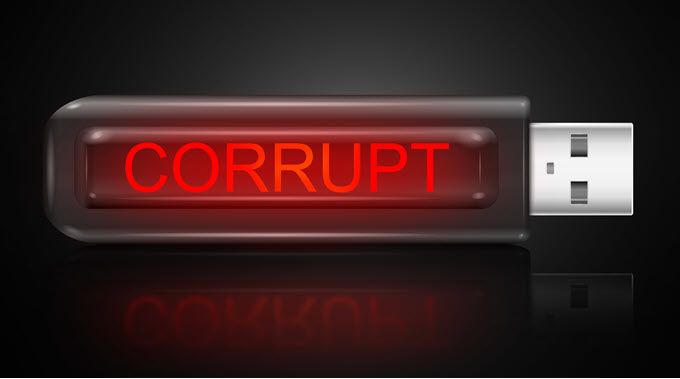The answer is Yes. Why Yes? You’ve just yanked it out like a bad tooth numerous times, and nothing has ever gone wrong. Why do you have to start caring now? What’s the worst that might happen?
There are lots of bad that might happen, and it’s only a matter of time. Let’s see what’s in store for you if you keep pulling it out, and why these bad things could happen.
How Do USB Drives Get Corrupted by Removing Without Ejecting?

How a USB drive and a computer communicate together is surprisingly complex. First, the pc must provide power to the USB drive in order that it can work.
Then the pc and therefore, the USB drive will ask one another to determine a connection that requires the pc to possess the correct drivers installed.
Today’s USB drives are all plug-and-play meaning that they can provide the needed drivers for the pc. Then the pc must know what data is on the USB drive so it can allow you to access it.
The computer executes this by reading the Master Boot Record (MBR) or Partition Boot Record (PBR) or directory structure on the USB.
All of that happens within the couple seconds before you begin using your USB flash drive.
In the process that you’re using the flash drive, you will think that it’s just reading files or each time you modify something it is immediately written to the drive. That’s not how it works.
When reading files, there’s still changes happening. The file’s metadata is getting modified by the system doing things like updating the last accessed or last changed date and time.
The changes happen in batches. you alter something, the change first takes place in a cache on your computer, then it finally gets written to the USB drive.
Also, other programs could also be accessing your USB drive and you don’t know it. If you’ve got antivirus or anti-malware software, it may well be checking your drive at any point in time.
So, at any time, even though you’re not doing anything with the flash drive, your PC may be using it. If you pull your USB drive out while any of those things are happening, you can damage your files, or the USB drive itself.
But wait, there’s more. There’s a whole commemoration that happens once you eject the USB drive.
Just as the PC and also the drive has an introduction phase like above, they even have a goodbye phase where they greet one last time, finish talking, then the computer disengages the USB and stops providing power.
If that doesn’t happen properly, corruption can happen. Apparently, the pc and USB need closure at the end of their relationship. the power supply part is vital too.
Ever unplug something from the wall and saw just a bit flash of electricity? An identical thing can happen when pulling out the flash drive, and this may corrupt your drive. It rarely happens, but it still does.
What is the Worst that Could Happen?
The worst-case situation is that your USB drive stops functioning entirely. you can’t write to it, you can’t read from it, it just doesn’t work.
Not a big deal if it’s stuff you don’t care about or if you’ve got it all backed up elsewhere. But let’s be honest, that’s never the case when it happens.
It happens when it has important documents, or you’re in haste to give a presentation with what’s on the USB drive. It never happens at a suitable time.
Fortunately, it would be possible to repair your USB flash drive and therefore the data thereon . Unless it was damaged by electricity after you pulled it out. That may happen.
Why Doesn’t This Happen All the Time?
Windows 10 includes a feature called Quick Removal that usually will prevent corruption from happening. the fast Removal policy ensures that Windows maintains the USB drive in a state where it’s ready to be removed at any time.
By default, Windows uses the fast Removal policy on your USB drives.
It’s not foolproof though. It’s still possible that you simply could remove the flash drive while it’s being written to or accessed by another program.
Why it doesn’t happen all the time is that computers are enormously fast. Within the time that you saved a file to your flash drive and then removed the drive out, your computer had already written the file.
How Do I Know I’m Using Quick Removal?
- Click the search bar ‘Type here to search” near your start button. Type device manager and hit enter.
- You’ll see the Device Manager as one of the search results. Click to open that.
- In Device Manager, expand Disk Drives and find your USB flash drive.
- Right-click on your USB flash drive and click on Properties.
- In the device’s properties window, click on the Policies tab. There you’ll see if your USB drive is about to use Quick Removal or Better Performance. If it isn’t set to Quick Removal and you want that, select it and click OK to proceed.
How Should I Eject the USB Drive?
In Windows, there are 2 good ways to eject the USB drive, so it goes through the required steps to confirm it ejects safely.
You’ll be able to eject a USB drive through the taskbar or in File Explorer. Let’s re-evaluate the way to do this .
Eject USB Drive from Taskbar
- Click on the USB icon in the taskbar. If you don’t see it, click on the up arrow to show all items in the taskbar.
- A small window will appear above this, listing all the devices plugged in via USB. Find the device you would like to eject and click on it.
- Once Windows has safely dismounted the USB flash drive, you’ll see the subsequent confirmation screen open. you can safely remove your drive now.
Eject USB Drive in Windows File Explorer
- Find the USB flash drive you would like to eject in File Explorer and right-click on it. in the menu that opens, click on Eject.
- Wait for a few of seconds and you’ll see the confirmation notification pop up by the clock in your taskbar. you’ll be able to now safely remove your flash drive.
Conclusion
The fact is, whether you knew or didn’t know about ejecting flash drives the right way, Now you know, you still will be removing your drives the old traditional way. Or you won’t?



